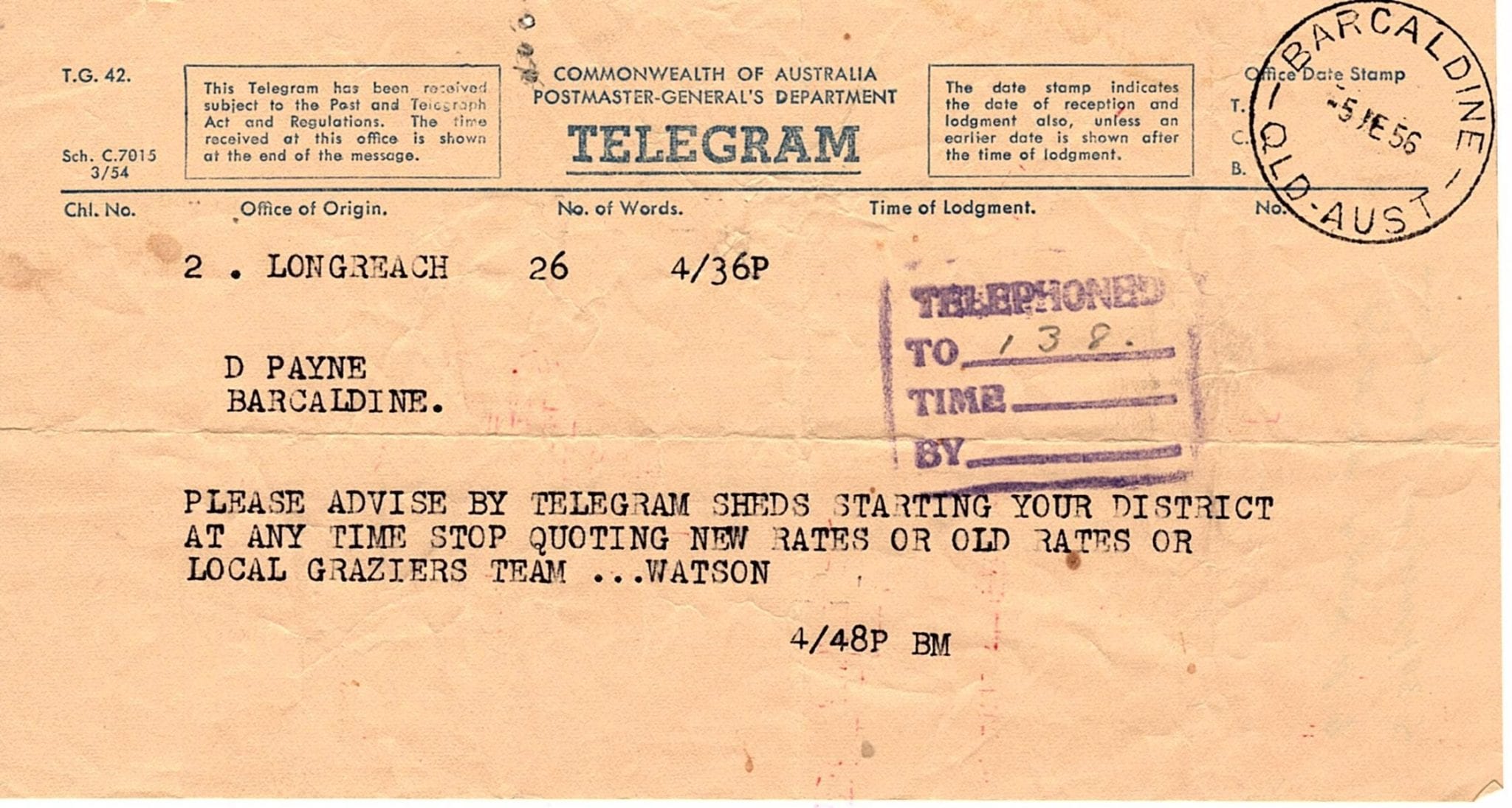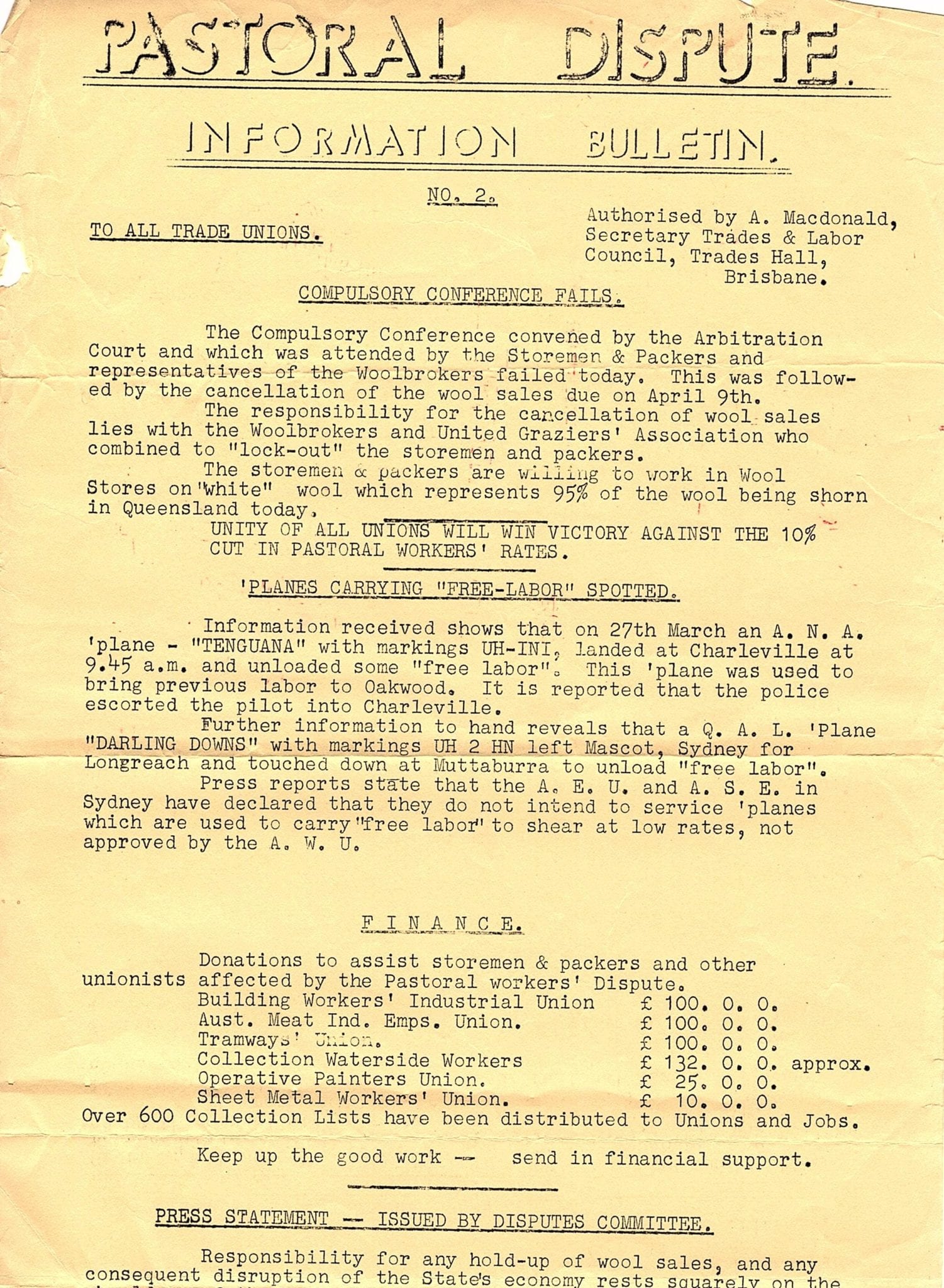In the 1880’s shearers wielded a lot of influence on our country. Despite us not yet being a single united nation, in the various states where wool growing was the major industry militant unionism arose with great co-operation between the various state organisations.
In those days, shearers and general farm workers were numerous. Wool was the biggest export commodity of most of the states but the working conditions of those who produced this golden fleece were poor. Are we any richer today?
In 1886, the leader of the Miners Union, William Spence and a 24 year old shearer, David Temple, established The Australasian Shearers Union (ASU) in Ballarat and set up headquarters in Creswick. In 1887 they set up branches in Bourke and Wagga Wagga. In the same year, the Queensland Shearers Union (QSU) was established at Blackall.
By 1890 this union had 3,721 registered members. At the same time, the ASU had recruited 20,000 members covering NSW, Victoria and South Australia and had promoted the establishment of the BRISBANE WORKER newspaper. The QSU became affiliated with the Australian Labour Federation (ALF) and called a strike involving 30,000 workers.

1891 Shearers Strike
The ASU then formed another union called the General Labourers Union (GLU) to cover all other farm workers and shed hands. At its annual conference a resolution was passed to reject the form of “Freedom” contract prepared by the Pastoralists organisations and the strike escalated.
The strike failed when the ASU conceded freedom of contract and the union could not continue supporting striking workers and the anti-union Queensland government sent in the military.
In 1892 the Queensland Unionists laid down a manifesto and formed the Queensland Labour Party under a large white gum tree in Barcaldine, now known as The Tree of Knowledge and where a monument erected to mark the occasion still stands today. This event is regarded as the formation and foundation of The Australian Labour Party.

In 1894 the ASU amalgamated with the GLU to form the Australian Workers Union (AWU) and the biggest strike in the state’s history, the Queensland Pastoral strike commences soon afterwards. This strike surpassed that of 1891. The combined weight of the amalgamated and affiliated unions were a greater force to be reckoned with. Groups of striking shearers roamed the countryside in armed conflict with police and pastoralists. Many stations were torched and property destroyed culminating with the burning of the woolshed at Dagworth Station near Winton with the incineration of 140 lambs. This incident gave rise to our most famous and best known unofficial anthem, Waltzing Matilda.
Dagworth Station was owned by the McPherson brothers, one of which, Bob, was a good friend of Banjo Paterson. Banjo came to visit his friend at Dagworth after the woolshed had been torched and learned of the catastrophe. The facts were that a striking itinerant German insurrectionist named Samuel “Frenchy” Hoffmeister started the fire. Hoffmeister lived in a camp at Kynuna Station on the south side of the Diamantina River. He was chased by the McPherson brothers and three police, constables Cafferty (#420), Daly (#89) and Dyer (176) but they failed to capture him. He committed suicide by shooting himself, apparently in a fit of remorse for the burning of the lambs in the fire that he started at the Dagworth woolshed His grave was discovered, and a cairn built at the Combo Waterhole, a billabong formed by the Diamantina River.
Back at Dagworth Station homestead, Banjo was intrigued by the story and started composing his lines to the accompaniment of Christina McPherson. Banjo was engaged at the time to another girl. The association he developed with Christina lead to the engagement being broken off. Christina was playing a tune on an autoharp which she had heard while attending the annual steeplechase at Warrnambool the previous April. The tune was a Scottish air named Craigilee. Banjo deviated from the precise facts to create his epic piece. Hoffmeister was not caught with a “Jumbuck in his tucker bag” nor did he “jump into the billabong”. He was running away and got away. There was no policeman #123. The facts as stated above are provided by Dr. Ross Fitzgerald, Associate Professor of History at Griffith University.
Regardless of the deviation of facts as told by Bob McPherson who was, after all, one of the pursuers, Banjo was telling a story based on the incident and what a wonderful stirring legacy he left and a powerful political allegory based on the 1894 shearers strike.
Dagworth Station today is no longer owned by the McPherson family and it is no longer a sheep station. It is now a cattle station but I have no doubt that the ghosts may still be heard if you pass by that billabong on any dark and windy night. I have been passed it in daylight so if you really want to hear the ghosts then get in your 4 x 4 Toyota Landcruiser and take a very long trip. You won’t regret the effort.

Returning to the reality of life in 1894, economic depression and drought brings a big drop in membership of the AWU. Numbers fell from 17,000 to 7,000, many local branches were closed and the head office was moved to Sydney. In 1901 an AWU member, Chris Watson, was elected to Federal Parliament and became leader of the Labour Party. Membership rose to 14,000 Aerger with the AWUQ increased this further to 30,000 and the AWU became the biggest and wealthiest union in Australia.
A pastoral strike in NSW inflamed tensions between the AWU and the newly formed Machine Shearers Union (MSU) but following the passing of the Federal Pastoral Industry Award by the Federal Conciliation and Arbitration Act of 1904 the MSU collapsed. Chris Watson became Prime Minister of the first national Labour government anywhere in the world. This is soon followed in 1910 when Andrew Fisher, with AWU support, becomes Australia’s Prime Minister heading the first majority national Labour government anywhere in the world.
In 1912, another shearer, Ted Grayndler, becomes general secretary of the AWU. Grayndler holds this role for 29 years and the federal seat of Grayndler, once held by Gough Whitlam, is named after him. Then followed a succession of amalgamations with other unions to create the AWU as far the biggest union by any measure with a membership of 86,000 and also the biggest union in the world.
Increasing size brought increasing internal tensions and at the 1931 election Labour lost office and remained in the wilderness until 1941 when the Curtin government was elected. Curtin died in office and his place was taken by Ben Chifley who lost office to Bob Menzies Liberal Party which remained in office for nearly 30 years. During this time the AWU and the Labour movement were in constant turmoil. Strikes all around the country were a regular occurrence, the influence of shearers and pastoral workers was diluted by the increased membership through amalgamations until 1956 when another national shearer's strike occurred resulting in another victory for pastoral workers with a large increase in wages.



In modern times the AWU has become somewhat of a pariah in the union movement being at odds frequently with other unions and the ACTU and tending to follow its own path when it suited but always recognising solidarity within the general Labour movement. With the vast membership now drawn from non-pastoral industries and a general reduction of employees within those industries, the influence of shearers has virtually disappeared but it should not be forgotten that, for better or worse, Australian shearers were the very foundation of the trade union movement throughout the world as we know it today.
Never forget, also, that had it not been for the shearers we would never have had WALTZING MATILDA.
We came from the sheep's back and we may live and die on coal or iron ore. But no matter what, it came from the back of the hard-working Aussie bloke who came from the shearing sheds, the bush and the heart of Australia.
But I can tell you this. It never came from a cafe in Melbourne and it never came from a Chinese windmill, a Chinese solar panel or a breathless Chinese virus.
It came from the heart and soul of hard working people who had shear sense, commonsense and a love of their place they called home.
BLOG COMMENTS POWERED BY DISQUS


















































